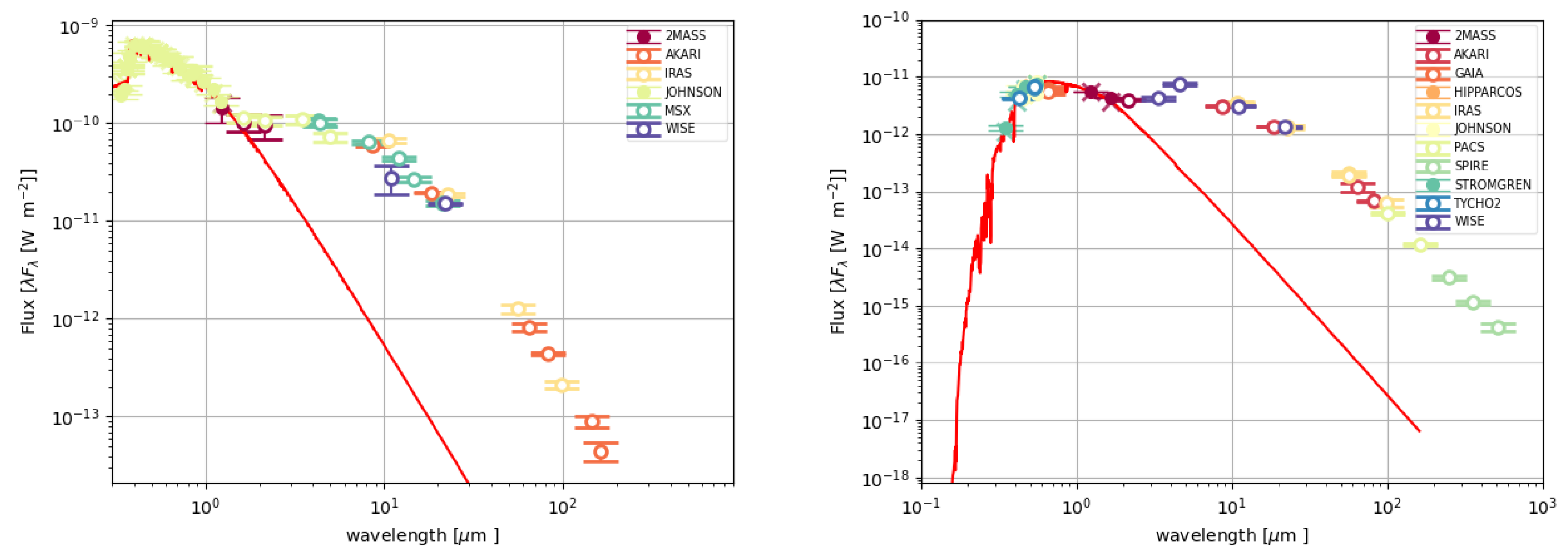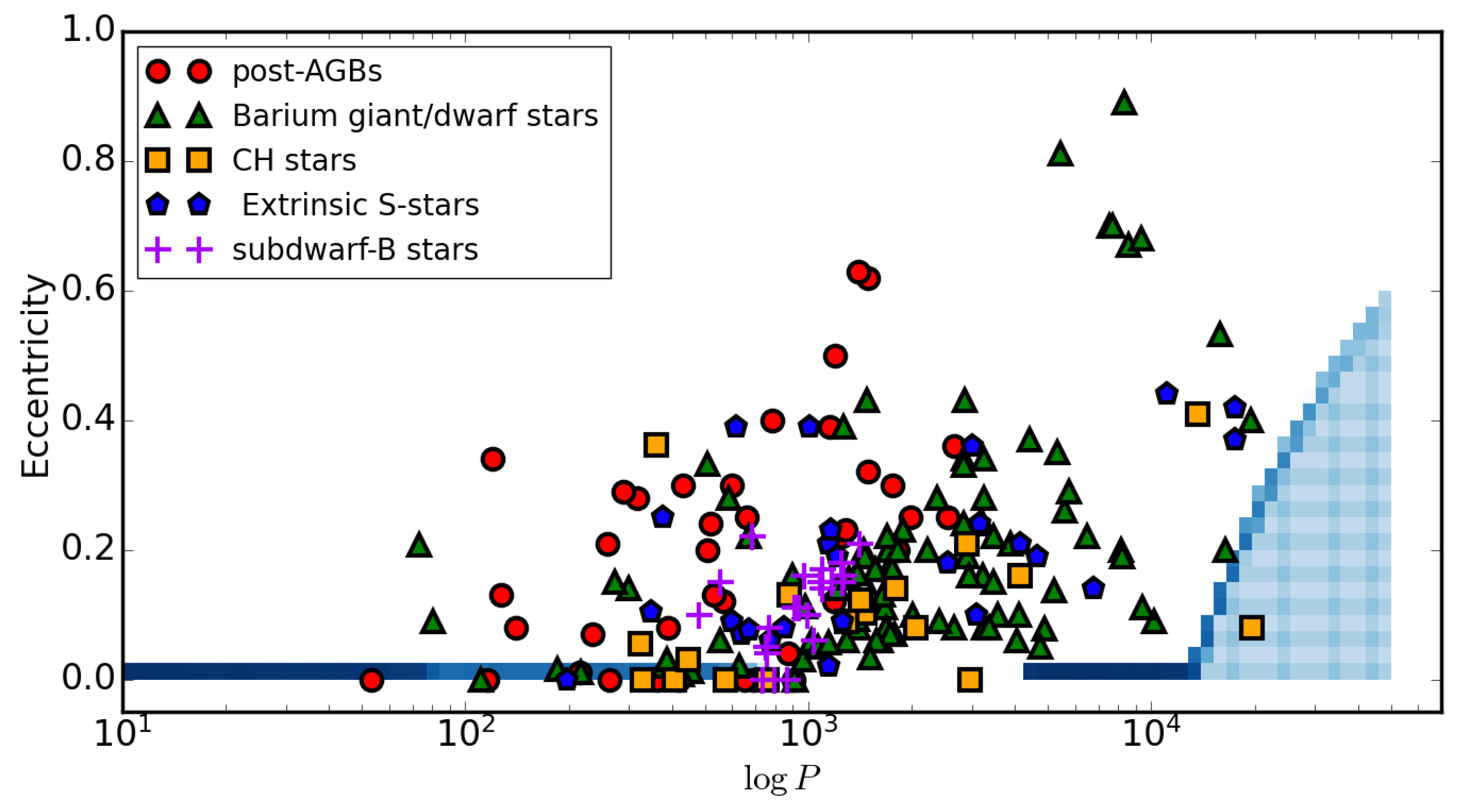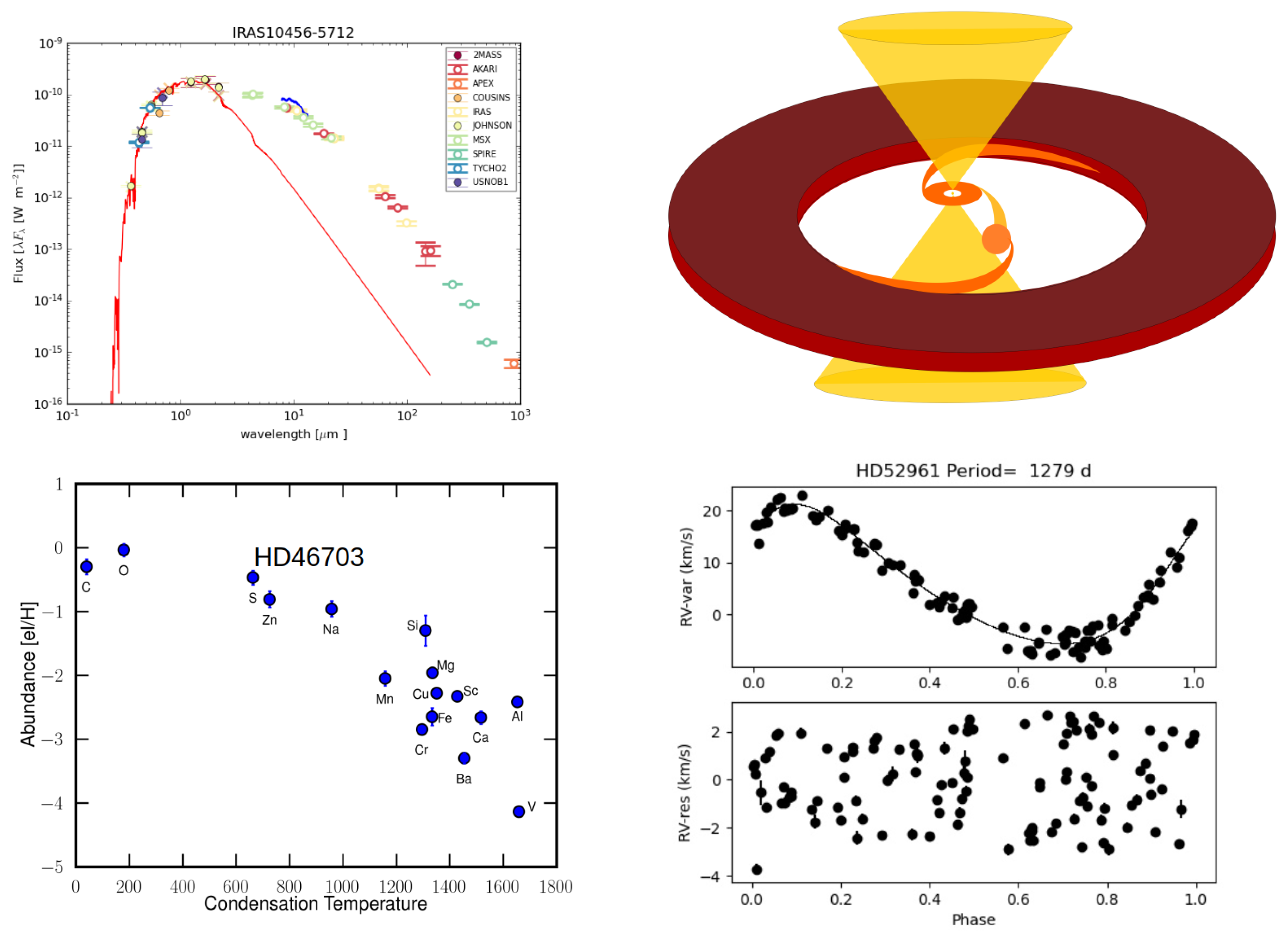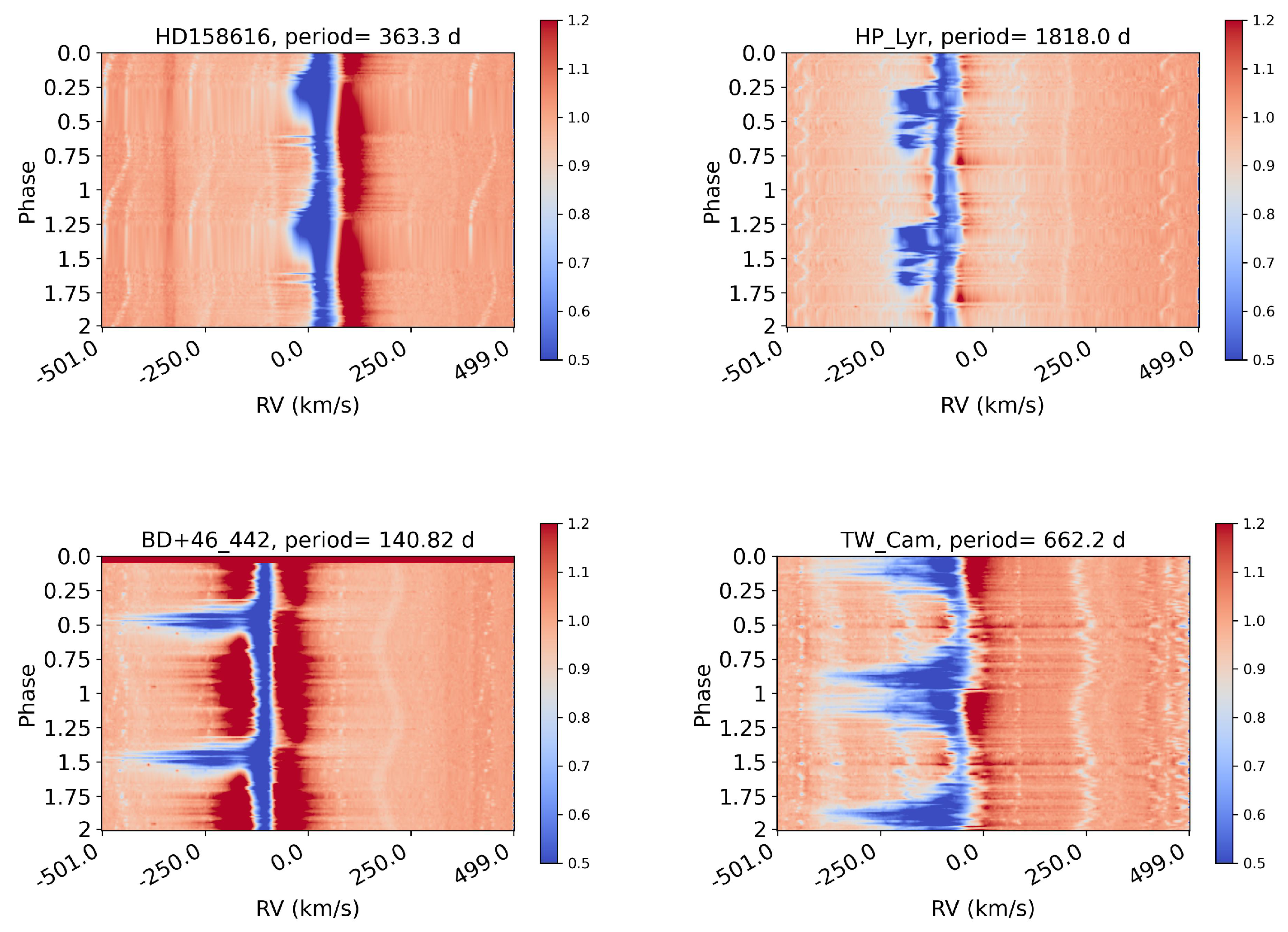Post-AGB Binaries as Interacting Systems
Abstract
1. Introduction
2. Orbital Distribution of Post-AGB Stars
3. Dissecting the Building Blocks
4. Ongoing Interaction Processes
4.1. Jets as MHD Disc Winds
4.2. Chemical Depletion
5. Conclusions
Funding
Data Availability Statement
Acknowledgments
Conflicts of Interest
References
- Van Winckel, H. Post-Agb Stars. ARA&A 2003, 41, 391–427. [Google Scholar]
- Van Winckel, H. Binary post-AGB stars as tracers of stellar evolution. In The Impact of Binaries on Stellar Evolution; Beccari, G., Boffin, H.M.J., Eds.; Camdridge University Press: Camdridge, UK, 2018; pp. 92–105. [Google Scholar]
- Oomen, G.M.; Van Winckel, H.; Pols, O.; Nelemans, G.; Escorza, A.; Manick, R.; Kamath, D.; Waelkens, C. Orbital properties of binary post-AGB stars. Astron. Astrophys. 2018, 620, A85. [Google Scholar] [CrossRef]
- Miroshnichenko, A.S.; Danford, S.; Zharikov, S.V.; Klochkova, V.G.; Chentsov, E.L.; Vanbeveren, D.; Zakhozhay, O.V.; Manset, N.; Pogodin, M.A.; Omarov, C.T.; et al. Properties of Galactic B[e] Supergiants. V. 3 Pup-Constraining the Orbital Parameters and Modeling the Circumstellar Environments. Astrophys. J. 2020, 897, 48. [Google Scholar] [CrossRef]
- Kluska, J.; Van Winckel, H.; Coppée, Q.; Oomen, G.M.; Dsilva, K.; Kamath, D.; Bujarrabal, V.; Min, M. A population of transition disks around evolved stars: Fingerprints of planets. Catalog of disks surrounding Galactic post-AGB binaries. Astron. Astrophys. 2022, 658, A36. [Google Scholar] [CrossRef]
- Kamath, D.; Wood, P.R.; Van Winckel, H. Optically visible post-AGB/RGB stars and young stellar objects in the Small Magellanic Cloud: Candidate selection, spectral energy distributions and spectroscopic examination. Rev. Mex. Astron. Astrofis. 2014, 439, 2211–2270. [Google Scholar] [CrossRef]
- Kamath, D.; Wood, P.R.; Van Winckel, H. Optically visible post-AGB stars, post-RGB stars and young stellar objects in the Large Magellanic Cloud. Rev. Mex. Astron. Astrofis. 2015, 454, 1468–1502. [Google Scholar] [CrossRef]
- Kamath, D.; Wood, P.R.; Van Winckel, H.; Nie, J.D. A newly discovered stellar type: Dusty post-red giant branch stars in the Magellanic Clouds. Astron. Astrophys. 2016, 586, L5. [Google Scholar] [CrossRef]
- Moltzer, C.A.S.; Pols, O.R.; Van Winckel, H.; Temmink, K.D.; Wijdeveld, M.W. Understanding post-RGB binaries through stable mass transfer. Astron. Astrophys. 2025; in preprint. [Google Scholar]
- Manick, R.; Kamath, D.; Van Winckel, H.; Jorissen, A.; Sekaran, S.; Bowman, D.M.; Oomen, G.M.; Kluska, J.; Bollen, D.; Waelkens, C. Spectroscopic binaries RV Tauri and DF Cygni. Astron. Astrophys. 2019, 628, A40. [Google Scholar] [CrossRef]
- Mohorian, M.; Kamath, D.; Menon, M.; Ventura, P.; Van Winckel, H.; García-Hernández, D.A.; Masseron, T. The first measurements of carbon isotopic ratios in post-RGB stars: SZ Mon and DF Cyg. Rev. Mex. Astron. Astrofis. 2024, 530, 761–782. [Google Scholar] [CrossRef]
- Van Winckel, H. Binary Star Research During the First Six Years of Operation of the HERMES Spectrograph at the 1.2 Mercator Telescope. In Proceedings of the EAS Publications Series; EAS: Nice, France, 2015; Volume 71–72, pp. 121–126. [Google Scholar] [CrossRef]
- Raskin, G.; van Winckel, H.; Hensberge, H.; Jorissen, A.; Lehmann, H.; Waelkens, C.; Avila, G.; de Cuyper, J.P.; Degroote, P.; Dubosson, R.; et al. HERMES: A high-resolution fibre-fed spectrograph for the Mercator telescope. Astron. Astrophys. 2011, 526, A69. [Google Scholar] [CrossRef]
- Pols, O.R.; Karakas, A.I.; Lattanzio, J.C.; Tout, C.A. Can Standard Evolution Models Explain the Properties of Barium Stars? In Proceedings of the ASP Conference Series; Corradi, R.L.M., Mikolajewska, J., Mahoney, T.J., Eds.; Astronomical Society of the Pacific: San Francisco, CA, USA, 2003; Volume 303, p. 290. [Google Scholar]
- Bonačić Marinović, A.A.; Glebbeek, E.; Pols, O.R. Orbital eccentricities of binary systems with a former AGB star. Astron. Astrophys. 2008, 480, 797–805. [Google Scholar] [CrossRef]
- Abate, C.; Pols, O.R.; Karakas, A.I.; Izzard, R.G. Carbon-enhanced metal-poor stars: A window on AGB nucleosynthesis and binary evolution. I. Detailed analysis of 15 binary stars with known orbital periods. Astron. Astrophys. 2015, 576, A118. [Google Scholar] [CrossRef]
- Nie, J.D.; Wood, P.R.; Nicholls, C.P. The Orbital Nature of 81 Ellipsoidal Red Giant Binaries in the Large Magellanic Cloud. Astrophys. J. 2017, 835, 209. [Google Scholar] [CrossRef]
- Yamaguchi, N.; El-Badry, K.; Shahaf, S. Population demographics of white dwarf binaries with intermediate separations: Gaia constraints on post-AGB mass transfer. arXiv 2025, arXiv:2505.14786. [Google Scholar]
- Jorissen, A.; Van Eck, S.; Van Winckel, H.; Merle, T.; Boffin, H.M.J.; Andersen, J.; Nordström, B.; Udry, S.; Masseron, T.; Lenaerts, L.; et al. Binary properties of CH and carbon-enhanced metal-poor stars. Astron. Astrophys. 2016, 586, A158. [Google Scholar] [CrossRef]
- Jorissen, A.; Boffin, H.M.J.; Karinkuzhi, D.; Van Eck, S.; Escorza, A.; Shetye, S.; Van Winckel, H. Barium and related stars, and their white-dwarf companions. I. Giant stars. Astron. Astrophys. 2019, 626, A127. [Google Scholar] [CrossRef]
- Escorza, A.; Karinkuzhi, D.; Jorissen, A.; Siess, L.; Van Winckel, H.; Pourbaix, D.; Johnston, C.; Miszalski, B.; Oomen, G.M.; Abdul-Masih, M.; et al. Barium and related stars, and their white-dwarf companions. II. Main-sequence and subgiant starss. Astron. Astrophys. 2019, 626, A128. [Google Scholar] [CrossRef]
- Hansen, T.T.; Andersen, J.; Nordström, B.; Beers, T.C.; Placco, V.M.; Yoon, J.; Buchhave, L.A. The role of binaries in the enrichment of the early Galactic halo. III. Carbon-enhanced metal-poor stars - CEMP-s stars. Astron. Astrophys. 2016, 588, A3. [Google Scholar] [CrossRef]
- Vos, J.; Østensen, R.H.; Vučković, M.; Van Winckel, H. The orbits of subdwarf-B + main-sequence binaries. III. The period-eccentricity distribution. Astron. Astrophys. 2017, 605, A109. [Google Scholar] [CrossRef]
- Toonen, S.; Nelemans, G.; Portegies Zwart, S. Supernova Type Ia progenitors from merging double white dwarfs. Using a new population synthesis model. Astron. Astrophys. 2012, 546, A70. [Google Scholar] [CrossRef]
- Kluska, J.; Van Winckel, H.; Hillen, M.; Berger, J.P.; Kamath, D.; Le Bouquin, J.B.; Min, M. VLTI/PIONIER survey of disks around post-AGB binaries. Dust sublimation physics rules. Astron. Astrophys. 2019, 631, A108. [Google Scholar] [CrossRef]
- Hillen, M.; Van Winckel, H.; Menu, J.; Manick, R.; Debosscher, J.; Min, M.; de Wit, W.J.; Verhoelst, T.; Kamath, D.; Waters, L.B.F.M. A mid-IR interferometric survey with MIDI/VLTI: Resolving the second-generation protoplanetary disks around post-AGB binaries. Astron. Astrophys. 2017, 599, A41. [Google Scholar] [CrossRef]
- Corporaal, A.; Kluska, J.; Van Winckel, H.; Bollen, D.; Kamath, D.; Min, M. Multi-wavelength VLTI study of the puffed-up inner rim of a circumbinary disc. Astron. Astrophys. 2021, 650, L13. [Google Scholar] [CrossRef]
- Corporaal, A.; Kluska, J.; Van Winckel, H.; Kamath, D.; Min, M. What does a typical full-disc around a post-AGB binary look like?—Radiative transfer models reproducing PIONIER, GRAVITY, and MATISSE data. arXiv 2023, arXiv:2301.02622. [Google Scholar]
- Andrych, K.; Kamath, D.; Kluska, J.; Van Winckel, H.; Ertel, S.; Corporaal, A. Second-generation protoplanetary discs around evolved binaries: A high-resolution polarimetric view with SPHERE/IRDIS. Rev. Mex. Astron. Astrofis. 2023, 524, 4168–4195. [Google Scholar] [CrossRef]
- Andrych, K.; Kamath, D.; Van Winckel, H.; Kluska, J.; Schmid, H.M.; Corporaal, A.; Milli, J. Multiwavelength high-resolution polarimetric imaging of second-generation disc around post-AGB binary IRAS 08544-4431 with SPHERE. Rev. Mex. Astron. Astrofis. 2024, 535, 1763–1777. [Google Scholar] [CrossRef]
- Gallardo Cava, I.; Gómez-Garrido, M.; Bujarrabal, V.; Castro-Carrizo, A.; Alcolea, J.; Van Winckel, H. Keplerian disks and outflows in post-AGB stars: AC Herculis, 89 Herculis, IRAS 19125+0343, and R Scuti. A&A 2021, 648, A93. [Google Scholar] [CrossRef]
- Bujarrabal, V.; Castro-Carrizo, A.; Alcolea, J.; Santand er-García, M.; van Winckel, H.; Sánchez Contreras, C. Further ALMA observations and detailed modeling of the Red Rectangle. Astron. Astrophys. 2016, 593, A92. [Google Scholar] [CrossRef]
- Bujarrabal, V.; Castro-Carrizo, A.; Alcolea, J.; Van Winckel, H.; Sánchez Contreras, C.; Santand er-García, M. A second post-AGB nebula that contains gas in rotation and in expansion: ALMA maps of IW Carinae. Astron. Astrophys. 2017, 597, L5. [Google Scholar] [CrossRef]
- Bujarrabal, V.; Castro-Carrizo, A.; Van Winckel, H.; Alcolea, J.; Sánchez Contreras, C.; Santand er-García, M.; Hillen, M. High-resolution observations of IRAS 08544-4431. Detection of a disk orbiting a post-AGB star and of a slow disk wind. Astron. Astrophys. 2018, 614, A58. [Google Scholar] [CrossRef]
- Bujarrabal, V.; Alcolea, J.; Van Winckel, H.; Santander-García, M.; Castro-Carrizo, A. Extended rotating disks around post-AGB stars. Astron. Astrophys. 2013, 557, A104. [Google Scholar] [CrossRef]
- Bollen, D.; Kamath, D.; Van Winckel, H.; De Marco, O.; Verhamme, O.; Kluska, J.; Wardle, M. The structure of jets launched from post-AGB binary systems. Astron. Astrophys. 2022, 666, A40. [Google Scholar] [CrossRef]
- Van Winckel, H.; Jorissen, A.; Gorlova, N.; Dermine, T.; Exter, K.; Masseron, T.; Østensen, R.; Van Eck, S.; Van de Steene, G. Post-AGB binaries in an evolutionary perspective: A HERMES monitoring programme. MemSAI 2010, 81, 1022. [Google Scholar]
- Gorlova, N.; Van Winckel, H.; Ikonnikova, N.P.; Burlak, M.A.; Komissarova, G.V.; Jorissen, A.; Gielen, C.; Debosscher, J.; Degroote, P. IRAS 19135+3937: An SRd variable as interacting binary surrounded by a circumbinary disc. Rev. Mex. Astron. Astrofis. 2015, 451, 2462–2478. [Google Scholar] [CrossRef]
- Bollen, D.; Van Winckel, H.; Kamath, D. Jet creation in post-AGB binaries: The circum-companion accretion disk around BD+46deg442. Astron. Astrophys. 2017, 607, A60. [Google Scholar] [CrossRef]
- Bollen, D.; Kamath, D.; Van Winckel, H.; De Marco, O. A spatio-kinematic model for jets in post-AGB stars. Astron. Astrophys. 2019, 631, A53. [Google Scholar] [CrossRef]
- Bollen, D.; Kamath, D.; De Marco, O.; Van Winckel, H.; Wardle, M. Determining mass-accretion and jet mass-loss rates in post-asymptotic giant branch binary systems. Astron. Astrophys. 2020, 641, A175. [Google Scholar] [CrossRef]
- Bollen, D.; Kamath, D.; Van Winckel, H.; De Marco, O.; Wardle, M. Jet parameters for a diverse sample of jet-launching post-AGB binaries. Rev. Mex. Astron. Astrofis. 2021, 502, 445–462. [Google Scholar] [CrossRef]
- Verhamme, O.; Kluska, J.; Ferreira, J.; Bollen, D.; De Prins, T.; Kamath, D.; Van Winckel, H. Magnetically driven winds from accretion disks in post-asymptotic giant branch binaries. Astron. Astrophys. 2024, 684, A79. [Google Scholar] [CrossRef]
- De Prins, T.; Van Winckel, H.; Ferreira, J.; Verhamme, O.; Kamath, D.; Zimniak, N.; Jacquemin-Ide, J. Jet formation in post-AGB binaries: Confronting cold magnetohydrodynamic disc wind models with observations. Astron. Astrophys. 2024, 689, A151. [Google Scholar] [CrossRef]
- Jacquemin-Ide, J.; Ferreira, J.; Lesur, G. Magnetically driven jets and winds from weakly magnetized accretion discs. Rev. Mex. Astron. Astrofis. 2019, 490, 3112–3133. [Google Scholar] [CrossRef]
- Casse, F.; Ferreira, J. Magnetized accretion-ejection structures. IV. Magnetically-driven jets from resistive, viscous, Keplerian discs. Astron. Astrophys. 2000, 353, 1115–1128. [Google Scholar] [CrossRef]
- Maas, T.; Van Winckel, H.; Lloyd Evans, T. Depletion in post-AGB stars with a dusty disc. II. Astron. Astrophys. 2005, 429, 297–308. [Google Scholar] [CrossRef]
- Giridhar, S.; Lambert, D.L.; Reddy, B.E.; Gonzalez, G.; Yong, D. Abundance Analyses of Field RV Tauri Stars. VI. An Extended Sample. Astrophys. J. 2005, 627, 432–445. [Google Scholar] [CrossRef]
- Rao, S.S.; Giridhar, S. Chemical Compositions of RV Tauri Stars and Related Objects. Rev. Mex. Astron. Astrofis. 2014, 50, 49–65. [Google Scholar]
- Kamath, D.; Van Winckel, H. Extrinsically metal-poor stars: Photospheric chemical depletion in post-AGB/post-RGB stars in the Large Magellanic Cloud. Rev. Mex. Astron. Astrofis. 2019, 486, 3524–3536. [Google Scholar] [CrossRef]
- Oomen, G.M.; Van Winckel, H.; Pols, O.; Nelemans, G. Modelling depletion by re-accretion of gas from a dusty disc in post-AGB stars. Astron. Astrophys. 2019, 629, A49. [Google Scholar] [CrossRef]
- Mohorian, M.; Kamath, D.; Menon, M.; Amarsi, A.M.; Van Winckel, H.; Fava, C.; Andrych, K. Tracing chemical depletion in evolved binaries hosting second-generation transition discs. Rev. Mex. Astron. Astrofis. 2025, 538, 1339–1366. [Google Scholar] [CrossRef]
- Waters, L.B.F.M.; Trams, N.R.; Waelkens, C. A scenario for the selective depletion of stellar atmospheres. Astron. Astrophys. 1992, 262, L37–L40. [Google Scholar]
- Lodders, K. Solar System Abundances and Condensation Temperatures of the Elements. Astrophys. J. 2003, 591, 1220–1247. [Google Scholar] [CrossRef]
- Kama, M.; Folsom, C.P.; Pinilla, P. Fingerprints of giant planets in the photospheres of Herbig stars. Astron. Astrophys. 2015, 582, L10. [Google Scholar] [CrossRef]
- Kluska, J.; Berger, J.P.; Malbet, F.; Lazareff, B.; Benisty, M.; Le Bouquin, J.B.; Absil, O.; Baron, F.; Delboulbé, A.; Duvert, G.; et al. A family portrait of disk inner rims around Herbig Ae/Be stars. Hunting for warps, rings, self shadowing, and misalignments in the inner astronomical units. Astron. Astrophys. 2020, 636, A116. [Google Scholar] [CrossRef]




Disclaimer/Publisher’s Note: The statements, opinions and data contained in all publications are solely those of the individual author(s) and contributor(s) and not of MDPI and/or the editor(s). MDPI and/or the editor(s) disclaim responsibility for any injury to people or property resulting from any ideas, methods, instructions or products referred to in the content. |
© 2025 by the author. Licensee MDPI, Basel, Switzerland. This article is an open access article distributed under the terms and conditions of the Creative Commons Attribution (CC BY) license (https://creativecommons.org/licenses/by/4.0/).
Share and Cite
Van Winckel, H. Post-AGB Binaries as Interacting Systems. Galaxies 2025, 13, 68. https://doi.org/10.3390/galaxies13030068
Van Winckel H. Post-AGB Binaries as Interacting Systems. Galaxies. 2025; 13(3):68. https://doi.org/10.3390/galaxies13030068
Chicago/Turabian StyleVan Winckel, Hans. 2025. "Post-AGB Binaries as Interacting Systems" Galaxies 13, no. 3: 68. https://doi.org/10.3390/galaxies13030068
APA StyleVan Winckel, H. (2025). Post-AGB Binaries as Interacting Systems. Galaxies, 13(3), 68. https://doi.org/10.3390/galaxies13030068





